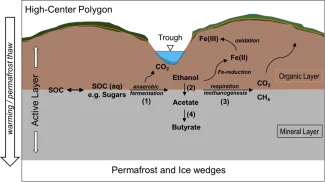The biogeochemistry team at ORNL recently conducted a laboratory incubation study to understand labile SOC transformations in polygonal tundra located in the Barrow Environmental Observatory. Led by post-doctoral associate Ziming Yang, the team used a combination of chromatographic and spectroscopy methods and examined the dynamic production and consumption of multiple SOC components, including free-reducing sugars, alcohols, and organic acids. They identified that sugars and alcohols quickly undergo anaerobic fermentation to produce CH4 and CO2 under the warming condition (Figure 5). Organic acids were also produced and subsequently utilized for the production of greenhouse gases through methanogenesis. The results also show a positive correlation between iron(III) reduction and acetate production and suggest that ferric ions and iron oxides served as electron acceptors in SOC respirations. Additionally, substrate addition experiments revealed that glucose is much more readily utilized than the recalcitrant organic substrate such as tannic acid for microbial degradation. Together, this work provides molecular evidence for SOC transformation pathways as influenced by warming in Arctic tundra. It also highlights the need for NGEE Arctic researchers to consider the vulnerability of different SOC pools in building process-based models under future climate change scenarios.
Reference:
Yang Z., Wullschleger S.D., Liang L., Graham D.E. and Gu B. (2016) Effects of warming on the degradation and production of low-molecular-weight labile organic carbon in an Arctic tundra soil. Soil Biology &  Biochemistry, 95: 202-211. DOI: 10.1016/j.soilbio.2015.12.022
Biochemistry, 95: 202-211. DOI: 10.1016/j.soilbio.2015.12.022
For more information, please contact:
Ziming Yang
yangz1@ornl.govBaohua Gu
gub1@ornl.gov

